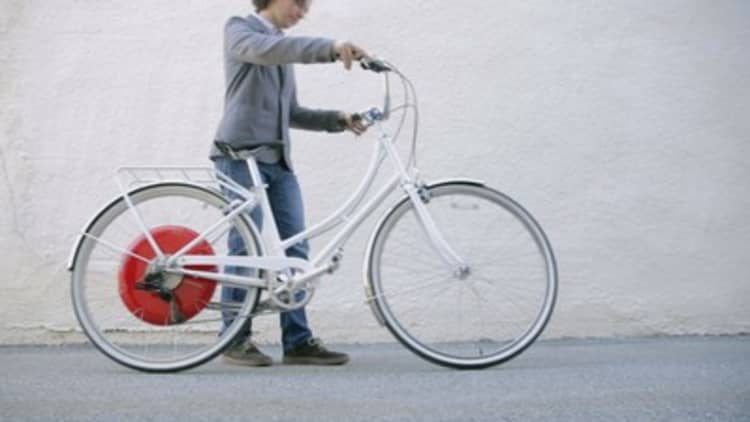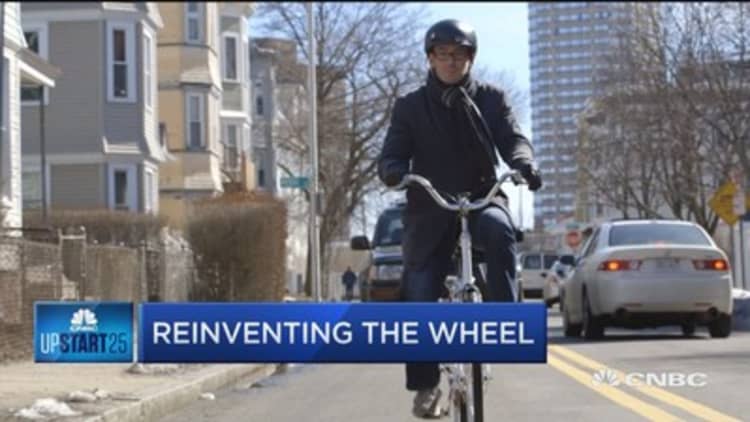
On the misery scale, commuting by car to and from work can rank right up there with root canals and cable bills — only with a lot more cussing. Picture Los Angeles at rush hour and feel the road rage. Mitigating that daily grind is among the challenges undertaken by MIT's SenseAble City Laboratory, where omni-disciplinary teams of brainiacs mastermind ways to create smarter urban environments. "Forty percent of our projects were around transportation," said Assaf Biderman, a former associate director at the lab whose expertise lies in physics and design.
In 2009 he and two colleagues invented an ingenious contraption called the Copenhagen Wheel, which essentially morphs an ordinary bicycle into a semi-autonomous robotic bike — and a hybrid alternative to the car. Centered around a conventional tire, rim and spokes, the wheel comprises a Frisbee-size bright red hub that houses a 350-watt motor, a 48-volt rechargeable lithium-ion battery, multiple sensors, Bluetooth wireless connectivity and an embedded control system activated by a smartphone mounted to the handlebars.
Weighing just under 16 pounds, it replaces a standard 26- or 28-inch rear wheel of almost any bike (currently not 20-inch wheels) and is compatible with existing single-speed or 7- to 10-gear drive trains made by Shimano or SRAM. The motor kicks in as soon as the rider starts pedaling, propelling the bike up to 20 mph for an average range of 30 miles on a full battery charge.
Biderman left SenseAble City in 2012 to launch Superpedestrian, a Cambridge, Massachusetts-based start-up (No. 7 on CNBC's Upstart 25 list) whose mission is to transform urban mobility, starting with the Copenhagen Wheel. Over the next four years, the company tweaked the wheel inside and out, tested prototypes, raised millions in venture capital, established a supply chain and set up a local manufacturing facility. In late 2016, Superpedestrian began cranking out and shipping finished products, priced at $1,200, including hundreds that had been preordered as long as three years ago, when the Copenhagen Wheel's introduction began generating some buzz.
A hip urban vehicle for the masses
While so many other transportation start-ups are focusing on self-driving autos, why did Superpedestrian turn to the pedal-powered two-wheeler devised in 1817 as the revolutionary replacement of the horse and buggy?
"We started with the bike because it's already the most common single-occupancy vehicle in the world," Biderman, Superpedestrian's CEO, explained. "But it's limited. The bike was invented when the average city was about 20 times smaller in land area than today's, and our body's physical capabilities have stayed the same since. So there's a fundamental mismatch. We realized that unless you somehow change the bike, it's hard to imagine it as a solution for transportation, and that means increasing its capacity to go farther."

The bicycle has certainly evolved during the past 200 years, from the early velocipede to the latest 30-speed, $10,000 carbon-fiber road racers. Yet commuting even on today's affordable hybrids and city bikes, solely powered by human oomph, can be an unappealing option if it means showing up at work in a sweaty lather or frozen to the bone. The development over the past decade of originally equipped electronic bikes — now offered by most every major bicycle manufacturer globally and a sector that Navigant Research predicts will grow to $24.3 billion by 2025 — presents a viable alternative for commuters. At an average cost of more than $3,000, however, e-bikes can be a turnoff.
That's another reason why retrofitting an existing bike makes sense to Biderman. Instead of another redesign of the bicycle in an increasingly competitive OEM industry, "we decided to build a robot that can be your mobility companion," he said. The wheel's smart technology not only allows the rider to go farther and faster and climb hills more easily but also automatically senses the effort from pedaling and provides the appropriate level of assistance. Its password-protected smartphone app records ride and road-condition data and delivers real-time diagnostics of the wheel's complex componentry. Recognizing that nefarious hackers might want to swipe that stored data or mess up its mechanics, "we've put a lot of effort into securing the wheel," Biderman contended.
Investor lure
Private investors are convinced that Superpedestrian is a secure bet. In two rounds of funding, the company has raised a total of $27.4 million from Boston-based venture capital firms General Catalyst and Spark Capital. "Our investors understand that we're looking at a problem that's not going away but is only getting worse," Biderman said, referring to traffic congestion's deleterious impact on people's lifestyles.
Cycling insiders appreciate the Copenhagen Wheel's value as well. Bill Strickland, editor-in-chief at Bicycling, said it's an interesting take on the e-bike phenomenon "because a lot of people have a bike in their garage and this is a way for them to get into that assisted mobility."
There's an erosion in the emotional connection to the car.Assaf Bidermanfounder and CEO of Superpedestrian
The magazine's testers have been impressed with the Copenhagen Wheel, as have non-experts. "It's a bit like going to the gym on the moon and doing your usual workout," wrote Boston Globe tech columnist Scott Kirsner in describing his test ride last year. Echoing that otherworldly boost the wheel lends, Harvard Crimson reporter Ben Cort wrote, "It felt as if some ethereal hand was holding me by the fender and steadily pushing me forward as I pedaled."
Tom Girard, director of retail operations at Zane's Cycles in Branford, Connecticut, was one of dozens of bike dealers who lined up to take a turn on a Copenhagen Wheel–equipped model displayed at the 2015 Interbike International Bicycle Exposition in Las Vegas. Zane's is among hundreds of bike shops nationwide that have signed up for Superpedestrian's Preferred Service Partner Program to offer demonstrations, installation and service. For now, Biderman said, sales of the wheel — a to-date number he declined to state — are exclusively through the company's website.
A global market poised to grow
Whether the Copenhagen Wheel succeeds as a workable commuting vehicle is to be determined. The U.S. Census Bureau's latest annual American Community Survey found that only a scant 0.63 percent of commutes to work were on a bike in 2014 — although those 904,463 commuters reflected a 62 percent increase since 2000. That's why Superpedestrian is investing heavily in Denmark, the Netherlands, German, Belgium and other European countries, where bicycle commuting is embedded in the culture.
Still, Biderman believes that the "U.S. market is going to explode," he said, buoyed by the thousands of demo rides the wheel has attracted and over-subscription in the company's orders-to-production ratio. "There's an erosion in the emotional connection to the car," he added. "That is the significant difference in the psychology of people vis-à-vis the automobile, which means it's the right time to disrupt it. But to disrupt it, you have to create something that is at least as emotionally compelling."
And if the Copenhagen Wheel doesn't relieve enough commuters' misery, Superpedestrian's next product release will include a semi-autonomous double-occupancy vehicle, Biderman claims, though he did not specify a date. "Not a tandem [bike], but something a lot better and a lot sexier — and I'll leave it at that."
— By Bob Woods, special to CNBC.com







